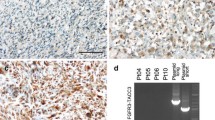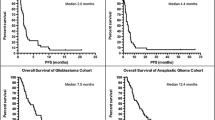Abstract
NF-kB inhibition by bortezomib enhances tamoxifen-induced apoptosis in preclinical glioma models. We conducted a single institution, phase II trial to evaluate efficacy and safety of high dose tamoxifen with bortezomib in adults with recurrent malignant gliomas. The primary endpoint was radiographic response. Concurrent enzyme inducing anticonvulsants and grade ≥2 peripheral neuropathy were exclusion criteria. Patients received tamoxifen (120 mg PO twice daily) and bortezomib (1.3 mg/m2 IV on days 3, 6, 10, 13, 24, 27, 31, and 34) per 6-week cycles. We enrolled 42 patients with anaplastic gliomas (AGs, n = 12) and glioblastomas (GBMs, n = 30), 32 males and 10 females. Median age was 38 years (range 22–65) and 48 years (range 19–68) for AGs and GBMs, respectively. median karnofsky performance status was 90 % (range 70–100) for AGs and 80 % (range 60–100) for GBMs. Median prior therapies was 3, ranging 1–7. Grade ≥3 toxicities included lymphopenia (4/42), hypophosphatemia (3/42), thromobocytopenia (2/42), and 1/42 with hyponatremia, headache, dyspnea, or DVT. One patient withdrew consent, two were removed for toxicity, and all others discontinued for progression. Among 40 patients evaluable for response, only one achieved stable disease for 3 months; all others progressed rapidly. For AGs and GBMs respectively, median progression-free survival was 5.9 and 5.7 weeks and median overall survival was 25.6 and 14.7 weeks. The study was closed due to poor accrual and therapeutic futility. Combination tamoxifen and bortezomib has no activity in recurrent malignant gliomas. Poor penetration across blood brain barrier of bortezomib likely limited efficacy.
Similar content being viewed by others
References
Dolecek TA, Propp JM, Stroup NE, Kruchko C (2012) CBTRUS statistical report: primary brain and central nervous system tumors diagnosed in the United States in 2005–2009. Neuro-Oncol 14(suppl 5):v1–v49
Louis D, Ohgaki H, Wiestler O et al (2007) The 2007 WHO classification of tumours of the central nervous system. Acta Neuropathol 114(2):97–109
Frankel SA, German WJ (1958) Glioblastoma multiforme. J Neurosurg 15(5):489–503
Pichlmeier U, Bink A, Schackert G, Stummer W (2008) Resection and survival in glioblastoma multiforme: an RTOG recursive partitioning analysis of ALA study patients. Neuro-Oncol 10(6):1025–1034
Wong ET, Hess KR, Gleason MJ et al (1999) Outcomes and prognostic factors in recurrent glioma patients enrolled onto phase II clinical trials. J Clin Oncol 17(8):2572
Laperriere N, Zuraw L, Cairncross G (2002) Radiotherapy for newly diagnosed malignant glioma in adults: a systematic review. Radiother Oncol 64(3):259–273
Scott CB, Scarantino C, Urtasun R et al (1998) Validation and predictive power of radiation therapy oncology group (RTOG) recursive partitioning analysis classes for malignant glioma patients: a report using RTOG 90-06. Int J Radiat Oncol Biol Phys 40(1):51–55
Tsao MN, Mehta MP, Whelan TJ et al (2005) The American Society for Therapeutic Radiology and Oncology (ASTRO) evidence-based review of the role of radiosurgery for malignant glioma. Int J Radiat Oncol Biol Phys 63(1):47–55
Stupp R, Mason WP, van den Bent MJ et al (2005) Radiotherapy plus concomitant and adjuvant temozolomide for glioblastoma. N Engl J Med 352(10):987–996
Wen PY, Kesari S (2008) Malignant gliomas in adults. N Engl J Med 359(5):492–507
De Graffenried LA, Chandrasekar B, Friedrichs WE et al (2004) NF-κB inhibition markedly enhances sensitivity of resistant breast cancer tumor cells to tamoxifen. Ann Oncol 15(6):885–890
Hui A-M, Zhang W, Chen W et al (2004) Agents with selective estrogen receptor (ER) modulator activity induce apoptosis in vitro and in vivo in er-negative glioma cells. Cancer Res 64(24):9115–9123
Oida K, Matsuda A, Jung K et al (2014) Nuclear factor-kB plays a critical role in both intrinsic and acquired resistance against endocrine therapy in human breast cancer cells. Sci Rep 4(4057):1–8
Zhou Y, Yau C, Gray JW et al (2007) Enhanced NFκB and AP-1 transcriptional activity associated with antiestrogen resistant breast cancer. BMC Cancer 7:59
Roccaro LM, Vacca A, Ribatti D (2006) Bortezomib in the treatment of cancer. Recent Pat Anti-Cancer Drug Discov 1(3):397–403
Williamson MJ, Silva MD, Terkelsen J et al (2009) The relationship among tumor architecture, pharmacokinetics, pharmacodynamics, and efficacy of bortezomib in mouse xenograft models. Mol Cancer Ther 8(12):3234–3243
Wen PY, Macdonald DR, Reardon DA et al (2010) Updated response assessment criteria for high-grade gliomas: response assessment in neuro-oncology working group. J Clin Oncol 28(11):1963–1972
Peng L, Ye X, Zhou Y, Zhang J, Zhao Q (2015) Meta-analysis of incidence and risk of peripheral neuropathy associated with intravenous bortezomib. Support Care Cancer 17:1–12
Mastronardi L, Puzzilli F, Ruggeri A (1998) Tamoxifen as a potential treatment of glioma. Anticancer Drugs 9:581–586
Patel S, DiBiase S, Meisenberg B et al (2012) Phase I clinical trial assessing temozolomide and tamoxifen with concomitant radiotherapy for treatment of high-grade glioma. Int J Radiat Oncol Biol Phys 82(2):739–742
Napolitano M, Keime-Guibert F, Monjour A et al (1999) Treatment of Supratentorial glioblastoma multiforme with radiotherapy and a combination of BCNU and tamoxifen: a phase II study. J Neurooncol 45(3):229–235
Brandes AA, Ermani M, Turazzi S et al (1999) Procarbazine and high-dose tamoxifen as a second-line regimen in recurrent high-grade gliomas: a phase II study. J Clin Oncol 17(2):645
Spence A, Peterson R, Scharnhorst J, Silbergeld D, Rostomily R (2004) Phase II study of concurrent continuous temozolomide (TMZ) and tamoxifen (TMX) for recurrent malignant astrocytic gliomas. J Neurooncol 70(1):91–95
Tang P, Roldan G, Brasher PMA et al (2006) A phase II study of carboplatin and chronic high-dose tamoxifen in patients with recurrent malignant glioma. J Neurooncol 78(3):311–316
Robins HI, Won M, Seiferheld WF et al (2006) Phase 2 trial of radiation plus high-dose tamoxifen for glioblastoma multiforme: RTOG protocol BR-0021. Neuro-Oncol 8(1):47–52
Michalski A, Bouffet E, Taylor R et al (2010) The addition of high-dose tamoxifen to standard radiotherapy does not improve the survival of patients with diffuse intrinsic pontine glioma. J Neurooncol 100(1):81–88
Trinh X, Sas L, Van Laere S et al (2012) A phase II study of the combination of endocrine treatment and bortezomib in patients with endocrine-resistant metastatic breast cancer. Oncol Rep 27(3):657–663
Acknowledgments
The National Cancer Institute (NCI) Intramural Research Program provided grant funding for this project [NCT#00108069]. Tetiana Wiggington, Leslie Moses, Laurie Rosenblatt, Julie Peretti, Tracy Cropper, and Maria Gonzalez provided administrative assistance with medical records and database management.
Author information
Authors and Affiliations
Corresponding author
Ethics declarations
Conflict of interest
None.
Funding
National Cancer Institute.
Rights and permissions
About this article
Cite this article
Odia, Y., Kreisl, T.N., Aregawi, D. et al. A phase II trial of tamoxifen and bortezomib in patients with recurrent malignant gliomas. J Neurooncol 125, 191–195 (2015). https://doi.org/10.1007/s11060-015-1894-y
Received:
Accepted:
Published:
Issue Date:
DOI: https://doi.org/10.1007/s11060-015-1894-y




